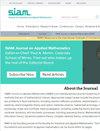由环境随机性驱动的种子传播互惠关系中的临界点
IF 2.1
4区 数学
Q1 MATHEMATICS, APPLIED
引用次数: 0
摘要
SIAM 应用数学杂志》第 84 卷第 1 期第 114-138 页,2024 年 2 月。 摘要种子传播互作机制是理解植被多样性及其保护的基础。在本研究中,我们提出了一个随机模型,该模型扩展了种子扩散互生的经典框架,以探讨环境随机性对种子扩散者和植物之间互生相互作用的影响。我们首先全面描述了确定性环境和随机环境下种子扩散互惠关系的长期动态。然后,我们分析了随机性与种子播散互惠关系在稳定状态之间的概率和时间之间的关系。此外,我们还评估了不同种群值下种子传播互利关系的灭绝风险,并相应地为这些值设定了灭绝预警级别。分析表明,环境随机性对临界现象的影响取决于各种情况,但也遵循一些可解释的趋势。向灭绝状态倾斜的概率(或时间)通常随着噪声强度的增加而单调增加(或减少),而向共存状态倾斜的概率通常在中等噪声强度时达到峰值。动物种群中的噪声有助于向共存状态倾斜,而植物种群中的噪声则会减缓向共存状态倾斜的速度。噪声引起的种群初始值预警水平的变化在吸引盆地边界附近最为明显,但足够大的噪声(尤其是对植物种群而言)可能会改变远离这些边界的风险。这些发现从理论上解释了环境随机性对种子传播互生中多稳过渡的影响,并可用于研究其他种群系统与环境随机性之间的相互作用。本文章由计算机程序翻译,如有差异,请以英文原文为准。
Tipping Points in Seed Dispersal Mutualism Driven by Environmental Stochasticity
SIAM Journal on Applied Mathematics, Volume 84, Issue 1, Page 114-138, February 2024.
Abstract. The mechanism of seed dispersal mutualism is fundamental to understanding vegetation diversity and its conservation. In this study, we propose a stochastic model that extends the classical framework of seed dispersal mutualism to explore the effects of environmental stochasticity on mutualistic interactions between seed dispersers and plants. We first provide a comprehensive picture of the long-term dynamics of seed dispersal mutualism in deterministic and stochastic environments. We then analyze the relationship between stochasticity and the probability and time that seed dispersal mutualism tips between stable states. Additionally, we evaluate the extinction risk of seed dispersal mutualism for different population values and accordingly assign extinction warning levels to these values. The analysis reveals that the impact of environmental stochasticity on tipping phenomena is scenario-dependent but follows some interpretable trends. The probability (resp., time) of tipping towards the extinction state typically increases (resp., decreases) monotonically with noise intensity, while the probability of tipping towards the coexistence state typically peaks at intermediate noise intensity. Noise in animal populations contributes to tipping toward the coexistence state, whereas noise in plant populations slows down the tipping toward the coexistence state. Noise-induced changes in warning levels of initial population values are most pronounced near the boundaries of the basin of attraction, but sufficiently loud noise (especially for plant populations) may alter the risk far from these boundaries. These findings provide a theoretical explanation for the effect of environmental stochasticity on multistability transitions in seed dispersal mutualism and can be utilized to study the interplay between other population systems and environmental stochasticity.
Abstract. The mechanism of seed dispersal mutualism is fundamental to understanding vegetation diversity and its conservation. In this study, we propose a stochastic model that extends the classical framework of seed dispersal mutualism to explore the effects of environmental stochasticity on mutualistic interactions between seed dispersers and plants. We first provide a comprehensive picture of the long-term dynamics of seed dispersal mutualism in deterministic and stochastic environments. We then analyze the relationship between stochasticity and the probability and time that seed dispersal mutualism tips between stable states. Additionally, we evaluate the extinction risk of seed dispersal mutualism for different population values and accordingly assign extinction warning levels to these values. The analysis reveals that the impact of environmental stochasticity on tipping phenomena is scenario-dependent but follows some interpretable trends. The probability (resp., time) of tipping towards the extinction state typically increases (resp., decreases) monotonically with noise intensity, while the probability of tipping towards the coexistence state typically peaks at intermediate noise intensity. Noise in animal populations contributes to tipping toward the coexistence state, whereas noise in plant populations slows down the tipping toward the coexistence state. Noise-induced changes in warning levels of initial population values are most pronounced near the boundaries of the basin of attraction, but sufficiently loud noise (especially for plant populations) may alter the risk far from these boundaries. These findings provide a theoretical explanation for the effect of environmental stochasticity on multistability transitions in seed dispersal mutualism and can be utilized to study the interplay between other population systems and environmental stochasticity.
求助全文
通过发布文献求助,成功后即可免费获取论文全文。
去求助
来源期刊
CiteScore
3.60
自引率
0.00%
发文量
79
审稿时长
12 months
期刊介绍:
SIAM Journal on Applied Mathematics (SIAP) is an interdisciplinary journal containing research articles that treat scientific problems using methods that are of mathematical interest. Appropriate subject areas include the physical, engineering, financial, and life sciences. Examples are problems in fluid mechanics, including reaction-diffusion problems, sedimentation, combustion, and transport theory; solid mechanics; elasticity; electromagnetic theory and optics; materials science; mathematical biology, including population dynamics, biomechanics, and physiology; linear and nonlinear wave propagation, including scattering theory and wave propagation in random media; inverse problems; nonlinear dynamics; and stochastic processes, including queueing theory. Mathematical techniques of interest include asymptotic methods, bifurcation theory, dynamical systems theory, complex network theory, computational methods, and probabilistic and statistical methods.

 求助内容:
求助内容: 应助结果提醒方式:
应助结果提醒方式:


